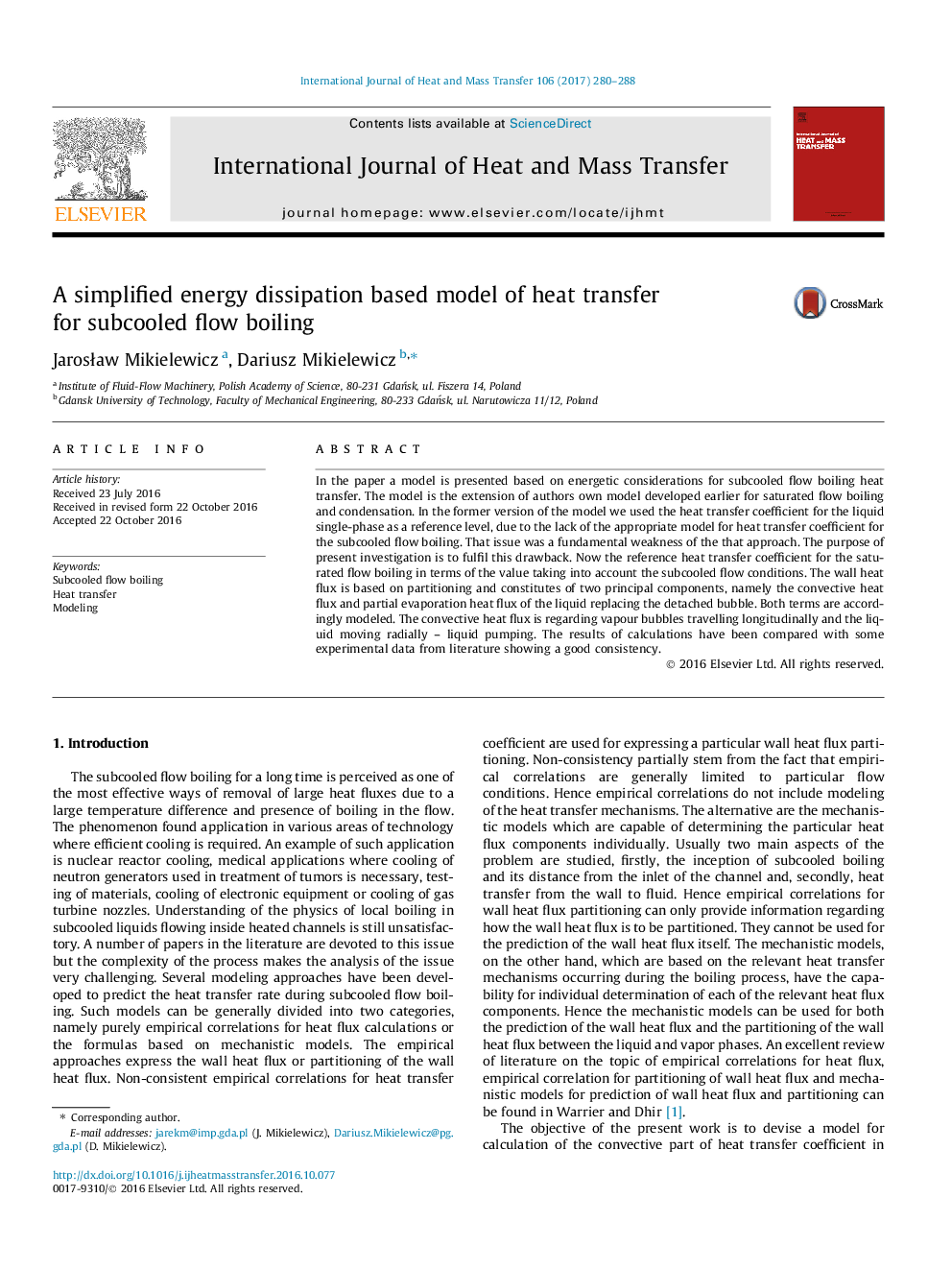| کد مقاله | کد نشریه | سال انتشار | مقاله انگلیسی | نسخه تمام متن |
|---|---|---|---|---|
| 4994770 | 1458036 | 2017 | 9 صفحه PDF | دانلود رایگان |
عنوان انگلیسی مقاله ISI
A simplified energy dissipation based model of heat transfer for subcooled flow boiling
ترجمه فارسی عنوان
یک مدل مبتنی بر تلفات انرژی ساده انتقال گرما برای جوش جریان بخار
دانلود مقاله + سفارش ترجمه
دانلود مقاله ISI انگلیسی
رایگان برای ایرانیان
کلمات کلیدی
جریان جوش زیرآبی، انتقال گرما، مدل سازی،
ترجمه چکیده
در مقاله یک مدل بر مبنای ملاحظات پر انرژی برای جریان گرمادهی جوش داده شده در زیر آب قرار داده شده است. این مدل گسترش مدل نویسندگان خود است که قبلا برای جریان جوش اشباع و تراکم ایجاد شده است. در نسخه قبلی مدل، از ضریب انتقال حرارت برای تک فاز مایع به عنوان یک سطح مرجع، به دلیل عدم وجود مدل مناسب برای ضریب انتقال گرما برای جوش جریان جوی تحت فرآیند استفاده شده است. این موضوع ضعف اساسی این رویکرد بود. هدف تحقیق حاضر این است که این نقص را برطرف کند. در حال حاضر ضریب انتقال گرما مرجع برای جریان جوش اشباع شده از لحاظ ارزش با توجه به شرایط جریان زیرخوش است. شار گرما دیواری بر اساس پارتیشن بندی و تشکیل دو جزء اصلی یعنی شار حرارتی کانواکتیو و شار حرارتی تبخیر جزئی مایع جایگزین حباب جدا شده است. هر دو اصطلاح به این ترتیب مدل شده اند. شار حرارتی کانوا در مورد حباب های بخار در حال حرکت طولی و مایع حرکت رادیال - پمپ مایع است. نتایج محاسبات با برخی داده های تجربی از ادبیات نشان داده شده است که نشان دهنده یک سازگاری خوب است.
موضوعات مرتبط
مهندسی و علوم پایه
مهندسی شیمی
جریان سیال و فرایندهای انتقال
چکیده انگلیسی
In the paper a model is presented based on energetic considerations for subcooled flow boiling heat transfer. The model is the extension of authors own model developed earlier for saturated flow boiling and condensation. In the former version of the model we used the heat transfer coefficient for the liquid single-phase as a reference level, due to the lack of the appropriate model for heat transfer coefficient for the subcooled flow boiling. That issue was a fundamental weakness of the that approach. The purpose of present investigation is to fulfil this drawback. Now the reference heat transfer coefficient for the saturated flow boiling in terms of the value taking into account the subcooled flow conditions. The wall heat flux is based on partitioning and constitutes of two principal components, namely the convective heat flux and partial evaporation heat flux of the liquid replacing the detached bubble. Both terms are accordingly modeled. The convective heat flux is regarding vapour bubbles travelling longitudinally and the liquid moving radially - liquid pumping. The results of calculations have been compared with some experimental data from literature showing a good consistency.
ناشر
Database: Elsevier - ScienceDirect (ساینس دایرکت)
Journal: International Journal of Heat and Mass Transfer - Volume 106, March 2017, Pages 280-288
Journal: International Journal of Heat and Mass Transfer - Volume 106, March 2017, Pages 280-288
نویسندگان
JarosÅaw Mikielewicz, Dariusz Mikielewicz,
